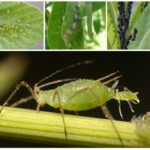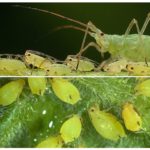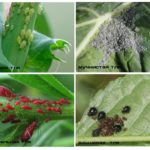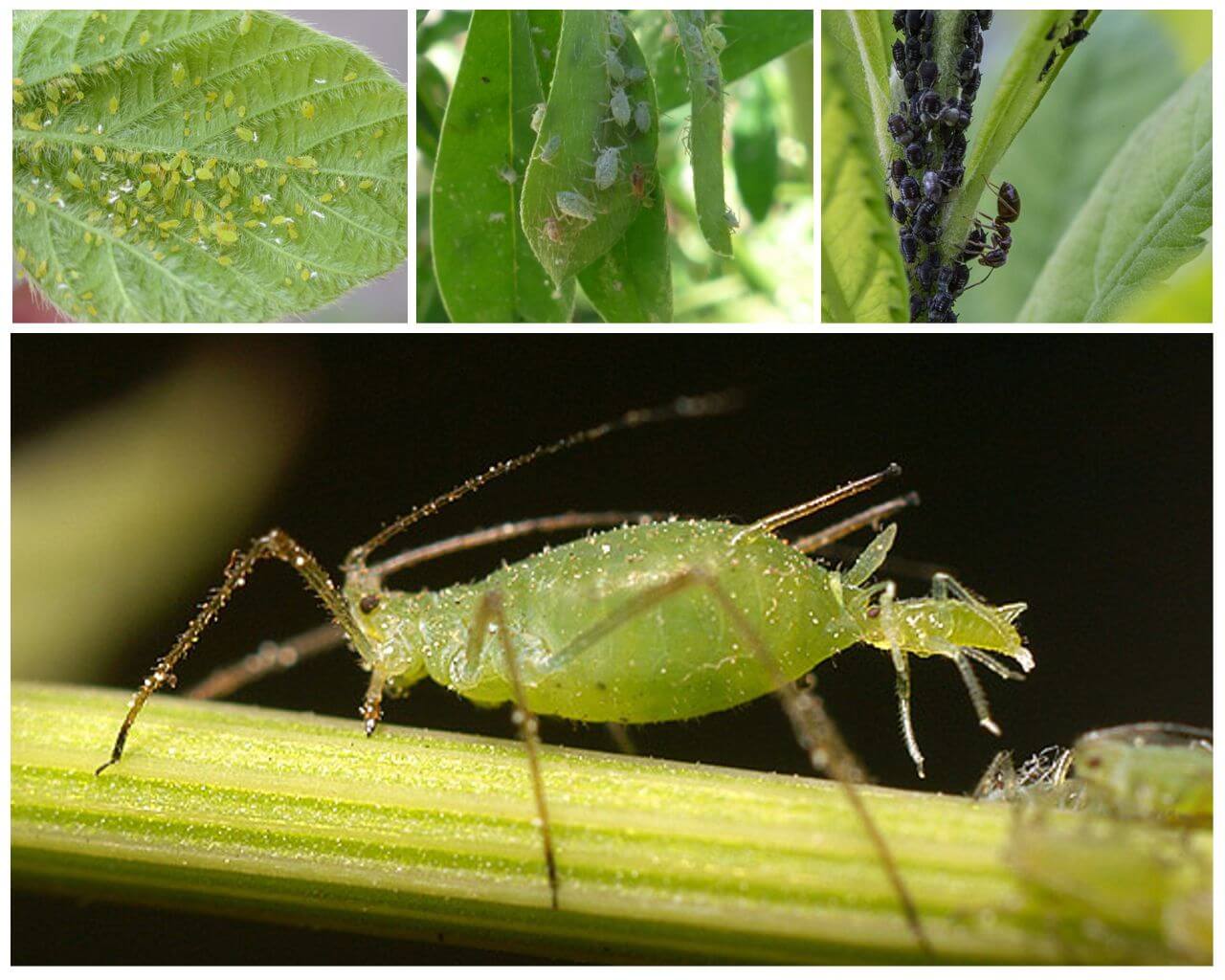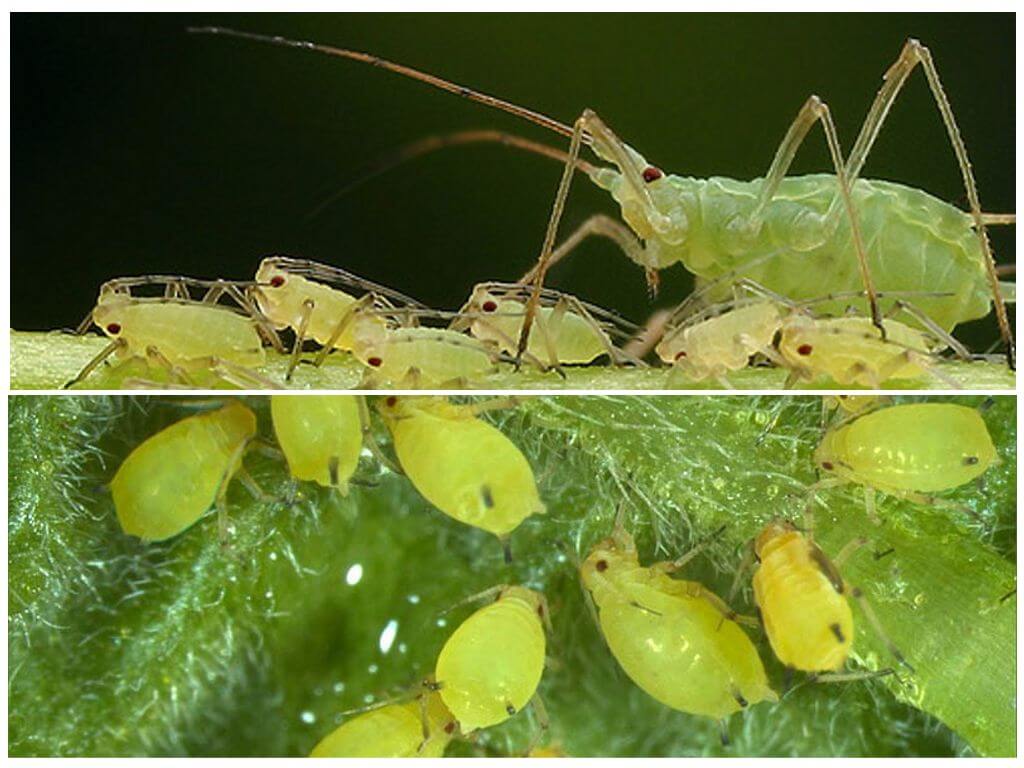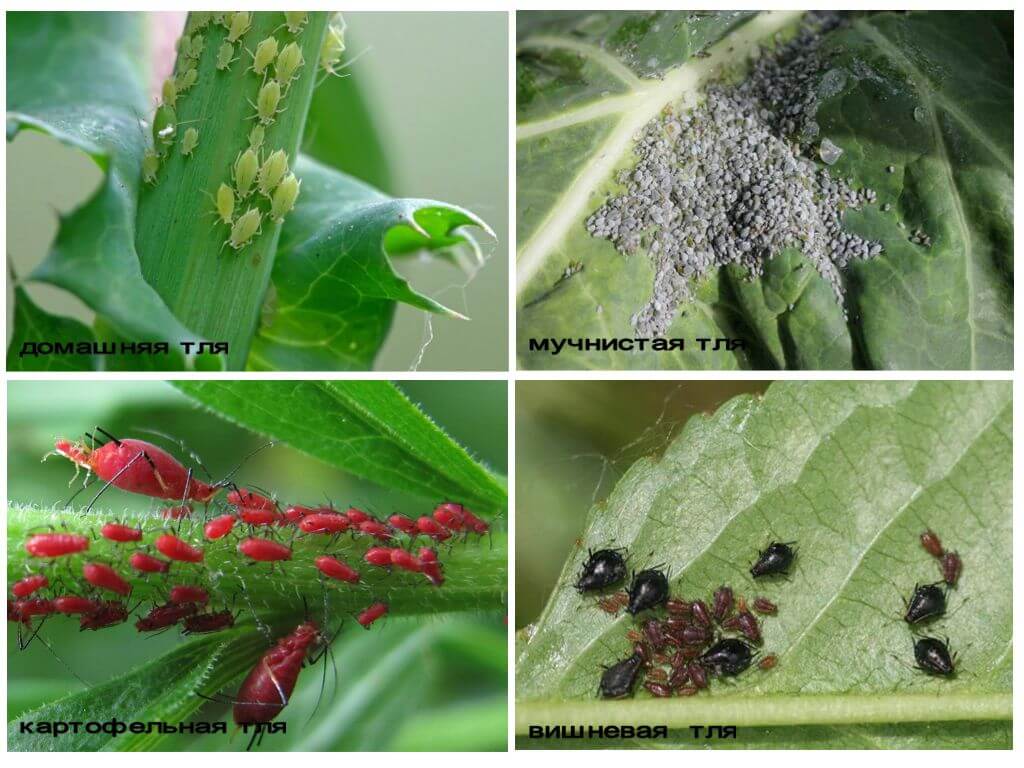What does aphid look like?
Content
- Aphid
- Aphid breeding
- Types of aphids
- Aphid classification
Aphids are one of the most malicious pests of garden and indoor plants, with which almost every summer resident or florist is familiar with firsthand knowledge. Indeed, thanks to their fertility, insects settle in suburban areas in huge colonies. Using plant juice as food, they are able to destroy entire gardens or fields.More details about the pest will tell this article.
Insect description
Hoping that the meeting with the dangerous enemy of the garden and garden will not happen, still not worth it. It is better to arm yourself with knowledge and find out what the aphid looks like to prevent the possibility of harming it.
- Aphids are small insects whose dimensions do not exceed 8 mm. Individuals living on houseplants are much smaller than about 0.5 mm.
- Depending on the type, the soft transparent body of the tiny pest can be in the form of a drop, an oval or an ellipse.
- The color of aphids corresponds to the tone of the plant on which the insect lives. Often there are black, green, red, pink or very transparent individuals.
- There are outgrowths and hairs of varying density and length on the bumpy surface.
- The antennae are located on the trapezoid head. They consist of several segments and serve as organs of hearing and touch.
- Due to the complex facet eyes, which are black, red or brown, aphids have clear vision.
- The mouth of the aphids serves as a small proboscis, with the help of which an insect makes a puncture in the leaf plate and sucks the juice out of it.
Interesting!
Thanks to a well-developed visual perception, aphids can even distinguish certain colors.
Insects move with the help of three pairs of long legs, which also perform jumping functions. Depending on the conditions of existence is aphid with and without wings. Moreover, each individual is assigned a certain type of activity in this colony. The presence of the wings is not a sexual sign, therefore the winged aphid can be both a female and a male. A distinctive feature of the flightless individuals are 3 extra simple eyes. Photo aphids below.
The abdomen is divided into 9 segmented parts. The first seven are spiracles. On subsequent segments are nipple tubes that perform excretory and secretory functions. The last segment is underdeveloped and has the appearance of a hairy ponytail.
Nutrition
Pests live in large colonies. Settling on the plant, they affect, above all, the leaves and young shoots. Aphids also eat flower buds, roots and stems of plants. As a result, the plantings weaken and gradually wither. Insects do not disdain any vegetation.Only certain types of aphids prefer certain types of trees, shrubs or grasses.
Quite often they coexist with black ants. The fact is that the fall (sweetish viscous liquid that the aphid releases in the process of vital activity) is what the ant eats and loves very much. It is for this reason that garden ants protect small pests from natural enemies: tumbling beetles and ladybugs.
Breeding
With the arrival of warm days from the deposited autumn, the wingless female appears in the bark of the tree of the aphids' eggs, and it becomes the founder of the colony. In the spring, under favorable conditions, the female aphids, breeding parthenogenetically, gives life to similar virgins.
On a note!
Aphid parthenogenesis is a form of sexual reproduction, during which eggs in adult females develop without mating with males.
It is also surprising how long such an individual lives - for its relatively short life, and the female virgin lives no more than a month, she manages to reproduce into the light several thousand similar beings.
Aphid larvae look like adults. They grow rapidly, undergoing several molts.After two weeks, the young individual becomes mature. Thus, the number of colonies is increased several times. When she reaches a critical size, females have wings. Flying on other plants, they give life to new colonies. And only with the onset of autumn, the population is replenished with full-fledged females and males. After mating, females lay eggs that hibernate and give rise to a new cycle.
What are the types of aphids
Insects are representatives of the order of hemiptera, in which there are about 4 thousand species (about a thousand live on the European continent). All species of aphids prefer warm and humid climatic conditions, which allow to increase their population several times. Under adverse conditions, pest colonies may simply die. Below are the most common types of pests.
House aphid
Indoor aphid, or as it is also called "home", includes several subspecies differing in body color. There is a red aphid, as well as individuals of white, black or green color.This pest is especially familiar to lovers of home flowers. They know how to get rid of pests settled on indoor plants.
Mealy Aphid
Mealy aphid is a cream-colored insect that has an oval-shaped body with bristles on its sides. The surface of the body is covered with a snow white patina. Meal aphids suffer from indoor and greenhouse plants, as well as citrus and grapes. The presence of insects produces a whitish hue that covers the leaves of the plant. This contributes to the deformation of the stem, the drying and falling off of leaves and buds.
Potato aphid
Wingless individuals whose oval body is colored red or green. Insect up to 4 mm long, has long antennae and tail. This species is remarkable in that it is adapted to low temperatures. Vegetables are such insects as food: potatoes, tomatoesbeet or cabbage. In winter, the potato aphid prefers to settle in indoor and greenhouse plants.
On a note!
It is possible to detect the pest by stains left by it, dried netting or mold in places of large concentrations of honeydew.
Cherry aphid
This species of aphid differs from its counterparts in a brilliant black color. Pests live mainly on cherry or sweet cherry, with the last plant more vulnerable. Eggs overwinter in the buds and on the branches of trees, with the arrival of spring females of the colony appear from them.
The black aphid is especially active on young shoots and foliage in the spring season. With the arrival of summer, the surface of the plants grows coarse, which leads to the death of most of the colony. However, up to this point, insects have time to cause tremendous damage to fruit plants: slower growth, the formation of fewer fruit buds, small and non-legible fruits. Trees infected with cherry aphids are susceptible to diseases and suffer frost worse.
Grain Aphid
This species is an inhabitant of the steppe and forest-steppe zones; individuals also live on fields sown with wheat, rye, barley or millet. The presence of insects during the period when the spike has not yet formed, leads to the fact that the plants remain practically unmursed. If pollination has already happened, the grains are formed by the lungs and most often empty.
Cabbage Aphid
It is a wingless insect whose dimensions do not exceed 2.5 mm. The body, covered with a greyish wax bloom, has an ovoid shape and a yellow-green color.
Aphids lay their eggs for wintering in cabbage residues remaining on the plot. By the middle of spring, larvae appear from them, which, like adults, feed on plant sap. What hinders the growth and development of the cabbage head.
Apple aphid
For apple trees 3 types of insects pose a threat:
- Red (blood) - the most dangerous type of aphids, whose representatives affect the root system of trees.
- Gray aphid - lives mainly on apples and hawthorn during the formation of leaves. From what only appeared foliage is twisted, and places of damage become covered with characteristic dark red color. This leads to the fall of the ovaries and the cessation of the growth of damaged young shoots, as a result of which they do not survive in cold weather.
- Green aphid - is a danger not only to apple trees, it also affects pear, irgu and mountain ash. The damaged aphids begin to turn black, and a black fungus appears on the branches.
Leaf aphid
Leaf or herbal aphid is active only in the summer, preferring young plants. It sucks the juice out of them, causing the leaves and branches to deform, which can even lead to the death of the seedling. It also settles on lawn and indoor flowers.
On a note!
The winged female flying aphid is colored yellow with a lemon shade, wingless individuals of brown color. It is this kind of aphids that ants graze.
Tobacco aphid
Tobacco (peach or greenhouse) aphid lives on tobacco, peach, plumalmond apricot and other plants. She settled on them at the very beginning of spring.
Peach aphid has a yellow-green color, which masks it well on damaged plants. As a result of the presence of insects, the leaves turn yellow and become lifeless. Honey dew, which the pest releases in the process of life, leads to the appearance of soot fungus, and subsequently to the fall of the foliage. If you do not take timely measures to combat aphids, then you can lose a large part of the crop.
To combat these insidious insects, there are good shop facilities. If you do not want to use chemicals, you can use folk remedies, well proven in the case.

